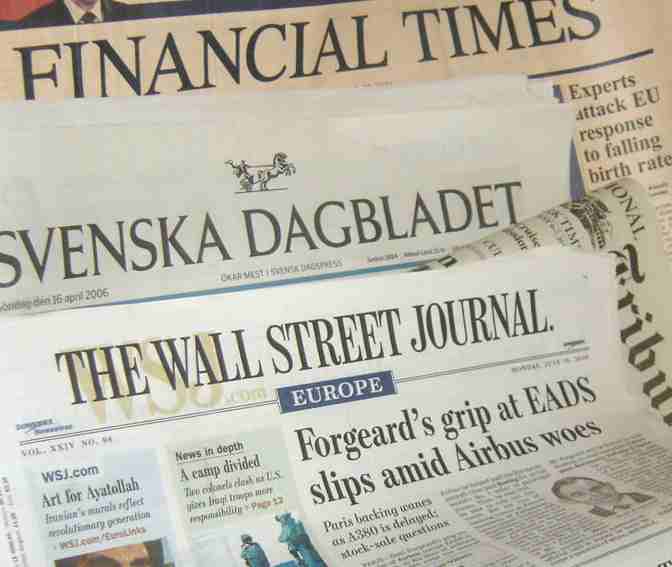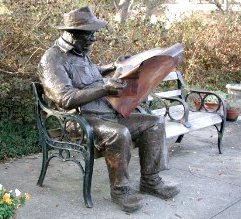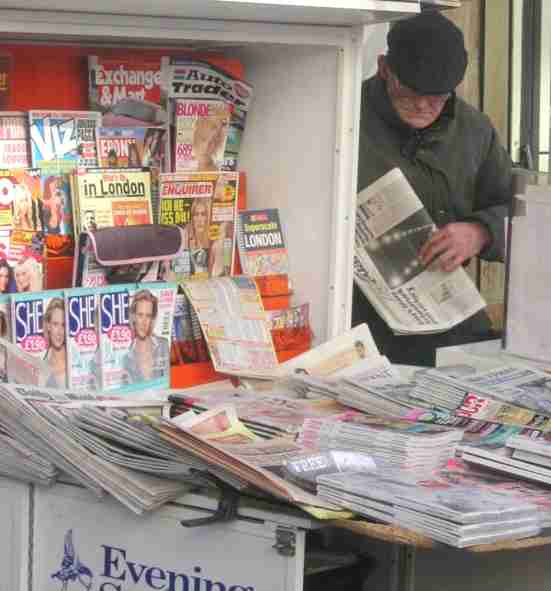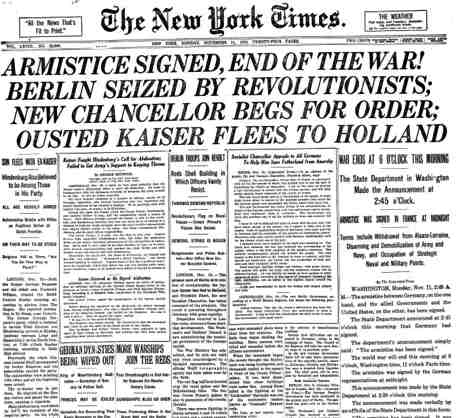|
NEWSPAPERS
|
||
|
HOME | AUTOMOTIVE | EDUCATION | FILMS | MUSIC | NEWS | POLITIC | SITE INDEX | SPORT |
||
|
A newspaper is a publication containing news, information and advertising, usually printed on low-cost paper called newsprint. It may be general or special interest, most often published daily or weekly.
The first printed newspaper was published in 1605, and the form has thrived even in the face of competition from technologies such as radio, television, and the internet. Recent developments on the internet are, however, posing major challenges to the business model of many newspapers. Paid circulation is declining in most countries, and advertising revenue, which makes up the bulk of most newspapers' income, is shifting from print to online, resulting in a general decline in newspaper profits. This has led to some predictions that newspapers’ role in society will shrink or even disappear, although historically, new media technologies such as radio and television never supplanted print media.
Newspapers: Financial Times, Svenska Dagbladet Wall Street Journal
Content
General-interest newspapers are usually journals of current news. Those can include political events, crime, business, culture, sports, and opinions (either editorials, columns, or political cartoons). Newspapers use photographs to illustrate stories; they use editorial cartoonists, usually to illustrate writing that is opinion, rather than news.
Some specific features a newspaper may include are:
Reading the newspaper: Brookgreen Gardens Pawleys Island, South Carolina, United States
Types of newspaper
A daily newspaper is issued every day, often with the exception of Sundays and some national holidays. Saturday, and where they exist Sunday, editions of daily newspapers tend to be larger, include more specialized sections and advertising inserts, and cost more. Typically, the majority of these newspapers' staff work Monday to Friday, so the Sunday and Monday editions largely depend on content done in advance or content that is syndicated.
Weekly newspapers are also common and tend to be smaller than daily papers.
Most nations have at least one newspaper that circulates throughout the whole country: a national newspaper, as contrasted with a local newspaper serving a city or region. In the United States and Canada, there are few truly national newspapers, with the notable exceptions The Wall Street Journal and USA Today in the US and The Globe and Mail and The National Post in Canada. Large metropolitan newspapers with expanded distribution networks such as The New York Times and The Washington Post can fill the role of de facto national newspapers. In the United Kingdom, there are numerous national newspapers, including The Independent,The Times, The Daily Telegraph, The Guardian, The Observer, The Daily Mail, The Sun, The Daily Express and The Daily Mirror.
As English has become the international language of business and technology, many newspapers formerly published only in non-English languages have also developed English-language editions. In places as varied as Jerusalem and Bombay (Mumbai), newspapers are printed to a local and international English-speaking public. The advent of the Internet has also allowed the non-English newspapers to put out a scaled-down English version to give their newspaper a global outreach.
There is also a small group of newspapers which may be characterised as international newspapers. Some, such as Christian Science Monitor and The International Herald Tribune, have always had that focus, while others are repackaged national newspapers or “international editions” of national-scale or large metropolitan newspapers. Often these international editions are scaled down to remove articles that might not interest the wider range of readers.
Job titles within the newspaper industry vary greatly. In the United States, the overall manager of the newspaper - sometimes also the owner - may be termed the publisher. This usage is less common outside the U.S., but throughout the English-speaking world the person responsible for content is usually referred to as the editor. Variations on this title such as editor-in-chief, executive editor, and so on, are common.
While most newspapers are aimed at a broad spectrum of readers, usually geographically defined, some focus on groups of readers defined more by their interests than their location: for example, there are daily and weekly business newspapers and sports newspapers. More specialist still are some weekly newspapers, usually free and distributed within limited areas; these may serve communities as specific as certain immigrant populations, or the local gay community.
Newspapers often refine distribution of ads and news through zoning and editioning. Zoning occurs when advertising and editorial content change to reflect the location to which the product is delivered. The editorial content often may change merely to reflect changes in advertising — the quantity and layout of which affects the space available for editorial — or may contain region-specific news. In rare instances, the advertising may not change from one zone to another, but there will be different region-specific editorial content. As the content can vary widely, zoned editions are often produced in parallel.
Editioning occurs in the main sections as news is updated throughout the night. The advertising is usually the same in each edition (with the exception of zoned regionals, in which it is often the ‘B’ section of local news that undergoes advertising changes). As each edition represents the latest news available for the next press run, these editions are produced linearly, with one completed edition being copied and updated for the next edition. The previous edition is always copied to maintain a Newspaper of Record and to fall back on if a quick correction is needed for the press. For example, both the New York Times and Wall Street Journal offer a regional edition, printed through a local contractor, and featuring locale specific content. The Journal's global advertising rate card provides a good example of editioning.
Format
Most modern newspapers are in one of three sizes:
Newspapers are usually printed on inexpensive, off-white paper known as newsprint. Since the 1980s, the newspaper industry has largely moved away from lower-quality letterpress printing to higher-quality, four-color process, offset printing. In addition, desktop computers, word processing software, graphics software, digital cameras and digital prepress and typesetting technologies have revolutionized the newspaper production process. These technologies have enabled newspapers to publish color photographs and graphics, as well as innovative layouts and better design.
To help their titles stand out on newsstands, some newspapers are printed on coloured newsprint. For example, the Financial Times is printed on a distinctive salmon pink paper, the Italian sports newspaper La Gazzetta dello Sport is printed on pink paper, while L'Équipe (formerly L'Auto) is printed on yellow paper. Both the latter promoted major cycling races and their newsprint colours were reflected in the colours of the jerseys used to denote the race leader; thus, the leader in the Giro d'Italia wears a pink jer
Online-only newspapers
With the introduction of the internet, web based newspapers have also started to be produced as online only publications, like Southport Reporter. To be a Web-Only newspaper they must be web published only and must not be part of or have any connection to hard copy formats. To be classed as a Online Only Newspaper the paper must also be regularly updated at a regular time and keep to a fixed news format, like a hardcopy newspaper. They must also be only published by professional media companies and regarded under the national/international press rules and regulations unlike blog sites. and other news websites it is run as a newspaper and is recognized by media groups in the UK, like the NUJ and/or the IFJ. Also they fall under the UK's PCC rules.
Electronic Paper
In February 2006, the Flemish daily De Tijd of Antwerp announced plans to distribute an electronic-ink version of the paper to selected subscribers. This will be the first such application of electronic ink to newspaper publishing. This type of electronic ink will be able to update any newspaper instantly.
Circulation and readership
The number of copies distributed, either on an average day or on particular days (typically Sunday), is called the newspaper’s circulation and is one of the principal factors used to set advertising rates. Circulation is not necessarily the same as copies sold, since some copies or newspapers are distributed without cost. Readership figures are higher than circulation figures because many copies are read by more than one person.
Newspaper vendor, Paddington, London, February 2005
According to the Guinness Book of Records, the daily circulation of the Soviet newspaper Trud exceeded 21,500,000 in 1990, while the Soviet weekly Argumenty i fakty boasted the circulation of 33,500,000 in 1991.
According to United Nations data from 1995 Japan has three daily papers —the Asahi Shimbun, Mainichi Shimbun and Yomiuri Shimbun— with circulations well above 4 million. Germany’s Bild, with a circulation of 4.5 million, was the only other paper in that category.
In the United Kingdom, The Sun is the top seller, with around 3.2 million copies distributed daily (late-2004).
In India, The Times of India is the largest English newspaper, with 2.14 million copies daily. According to the 2006 National Readership Study, the Dainik Jagran is the most-read, local-language (Hindi) newspaper, with 21.2 million readers [2].
In the U.S., USA Today has a daily circulation of approximately 2 million, making it the most widely distributed paper in the country.
A common measure of a newspaper’s health is market penetration. Market penetration is expressed as a percentage of households that receive a copy of the newspaper against the total number of households in the paper’s market area. In the 1920s, on a national basis in the U.S., daily newspapers achieved market penetration of 130 percent (meaning the average U.S. household received 1.3 newspapers). As other media, such as radio and television, began to compete with newspapers, and as printing became easier and less expensive giving rise to a greater diversity of publications, market penetration began to decline. It wasn't until the early 1970s, however, that market penetration dipped below 100 percent. By 2000, it was 53 percent 1.
Advertising
Most newspapers make nearly all their money from advertising; the income from the customer’s payment at the news-stand is small in comparison. For that reason, newspapers are inexpensive to buy, and some are free. The portion of the newspaper that is not advertising is called editorial content, editorial matter, or simply editorial, although the last term is also used to refer specifically to those articles in which the newspaper and its guest writers express their opinions. In recent years, the advertorial emerged. Advertorials are most commonly recognized as an opinion-editorial which third-parties pay a fee to have included in the paper. Advertorials commonly advertise new products or techniques, such as a new design for golf equipment, a new form of laser surgery, or weight-loss drugs. The tone is usually closer to that of a press release than of an objective news story.
Publishers of commercial newspapers strive for higher circulation, so that advertising in their newspaper becomes more effective, allowing the newspaper to attract more advertisers and to charge more for the service. But some advertising sales also market demographics: some newspapers might sacrifice higher circulation numbers in favor of an audience with a higher income.
Many paid-for newspapers offer a variety of subscription plans. For example, someone might want only a Sunday paper, or perhaps only Sunday and Saturday, or maybe only a workweek subscription, or perhaps a daily subscription.
Some newspapers provide some or all of their content on the internet, either at no cost or for a fee. In some cases, free access is available only for a matter of days or weeks, after which readers must register and provide personal data. In other cases, free archives are provided.
Newspaper journalism
Since newspapers began as a journal (record of current events), the profession involved in the making of newspapers began to be called journalism. Much emphasis has been placed upon the accuracy and fairness of the journalist — see Ethics.
In the yellow journalism era of the 19th century, many newspapers in the United States relied on sensational stories that were meant to anger or excite the public, rather than to inform. The more restrained style of reporting that relies on fact checking and accuracy regained popularity around World War II.
Criticism of journalism is varied and sometimes vehement. Credibility is questioned because of anonymous sources; errors in facts, spelling, and grammar; real or perceived bias; and scandals involving plagiarism and fabrication.
In the past, newspapers have often been owned by so-called press barons, and were used either as a rich man’s toy, or a political tool. More recently in the United States, a greater number of newspapers (and all of the largest ones) are being run by large media corporations such as Gannett (the largest in the United States), The McClatchy Company, Cox, LandMark, Morris Corporation, The Tribune Company, Hollinger International, News Corporation etc. Many industry watchers have concerns that the growing need for profit growth natural to corporations will have a negative impact on the overall quality of journalism.
There is no doubt, however, that newspapers have, in the modern world, played an important role in the exercise of freedom of expression. Whistle-blowers, and those who “leak” stories of corruption in political circles often choose to inform newspapers before other mediums of communication, relying on the perceived willingness of newspaper editors to expose the secrets and lies of those who would rather cover them. However, there have been many circumstances of the political autonomy of newspapers being curtailed.
Even though the opinions of the owners are often relegated to the editorial section, and the opinions of other writers and readers are in the op-ed (“opposite the editorial page”) and letters to the editors sections of the paper, newspapers have been used for political purposes by insinuating some kind of bias outside of the editorial section and into straight news. For example, The New York Times is often criticised for a perceived leftist slant to its stories, or, by others, for supporting the American political establishment, whereas the opinion pages (but not the news pages) of the The Wall Street Journal generally take right-wing positions.
Some ways newspapers have tried to improve their credibility are: appointing ombudsmen, developing ethics policies and training, using more stringent corrections policies, communicating their processes and rationale with readers, and asking sources to review articles after publication. Many larger newspapers are now using more aggressive random fact-checking to further improve the chances that false information will be found before it is printed.
The future of newspapers
The future of newspapers is cloudy, with overall readership slowly declining in most developed countries due to increasing competition from television and the Internet. The 57th annual World Newspaper Congress, held in Istanbul in June 2004, reported circulation increases in only 35 of 208 countries studied. Most of the increases came in developing countries, notably China and India
Front page of The New York Times on Armistice Day, November 11, 1918
A report at the gathering indicated that China tops total newspaper circulation, with more than 85 million copies of papers sold every day, followed by India with 72 million—China and India are the two most populous countries in the world—followed by Japan with 70 million and the United States with 55 million. The report said circulation declined by an average of 2.2 percent across 13 of the 15 countries that made up the European Union before May 1. The biggest declines were in Ireland, down 7.8 percent; Britain, down 4.7 percent; and Portugal, where numbers fell by 4.0 percent. One growth area is the distribution of free daily newspapers, which are not reflected in the above circulation data. Led by the Metro chain of newspapers, they grew 16 percent in 2003.
Another growth area is high-quality tabloids, particularly in the UK, where several of the major broadsheets are experimenting with the format (see “Switch to smaller sizes”). Smaller and easier to hold than broadsheets, but presenting serious journalism rather than traditional tabloid fodder, they appear to have drawn some younger readers who are otherwise abandoning newspapers.
Newspapers also face increased competition from internet sites such as Craigslist for classified ads, especially for jobs, real estate, and cars, the advertising of which has long been key sources of newspaper revenue. Also from online only newspapers. Already in the UK a newspaper called Southport Reporter started out in 2000 and remains online as a recognized newspaper, but only published online and others now exist through out the world. This opens the debate as to "What is a newspaper".
However, many believe that the internet can itself be used to newspapers’ advantage. External links to lists of newspapers
News A to Z directory, please click on the links below to find your favourite news or to contact the media to tell your story:
A - Z of officer investigations
The above is just a few of a number of persons likely to be investigated in respect of certain cases brought against Wealden Action Group members, on the instigation of known Masons, councillors, or planning officers, many of which are themselves Masons.
Full details of this case will be available for publishing in newspapers from 25 April 2008 subject to confirmation. This will include full disclosure of all factors relied on photographs of the officers concerned, the CPS staff, expert witnesses, teachers and the subjects of the allegations, the defendant, alleged victim and family and others, video footage, transcripts and an exclusive from the defendant. The case is to be heard in September 2007 at a Crown Court in Sussex, which we will advise of closer to the time.
Newspapers are warned that interim, they should be exceptionally careful about reporting this matter, due to a Section 39 Order. Those in attendance at Court will already know the identity of the girl and that a Not Guilty plea has been entered on all counts.
Armed with the name of the girl, newspaper reporters will be able to investigate the matter for themselves, for the purposes of balanced reporting at the appropriate time, but should take special care where allegations are already on the table with the police investigating the possibility that such reporting is likely to reveal the identity of the girl concerned to the general public.
This case looks set to be every bit as exciting as the BBC 'The Verdict' drama. It is bound to raise a whole raft of questions as to social issues, how the system works, who it protects, who it doesn't protect and what might have gone wrong within the family concerned. Just who the victim is in these cases is sometimes hard to define.
As for the players, what will happen to them? How will this affect their lives, their family and future, and what are the lesson to be learned? See below for details.
F.A.C.T.
(Falsely Accused Carers and Teachers)
Guidance
for education staff and volunteers in schools
Send a press release: Sending a release to PA PR Services Contact
The Press Association news desk on: T: +44 (0) 20 7963 7000
E: information@pa.press.net Please note that all attachments will be ripped out as these e-mails are directed into PA's news system. Any press release copy needs to be copied and pasted into the e-mail itself. Content sent to copy@pa.press.net will be considered by the newsdesk and may be passed to a reporter to be followed up.
PA does, however, distribute full-text press releases directly to newsrooms on their PA Mediapoint service. To include a press release on this service, please contact PA's partners direct :
The Press Association 292 Vauxhall Bridge Road, London, SW1V 1AE More information is available on this site, or by contacting Martin Huckett: T: +44 (0) 20 7963 7849 E:mailto:martinhu@pa.press.net
WE ACCEPT NO RESPONSIBILITY FOR THE ACCURACY OF ANY FEATURED LINKS
| ||
|
IF YOU HAVE ANY GOOD STORIES TO TELL WE'D LIKE TO HEAR FROM YOU WITH PICTURES, ETC. OR, WHY NOT BUILD A WEBSITE OF YOUR OWN TO TELL YOUR STORY. WE WILL LINK TO YOUR SITE WITH A SHORT SUMMARY.
|



